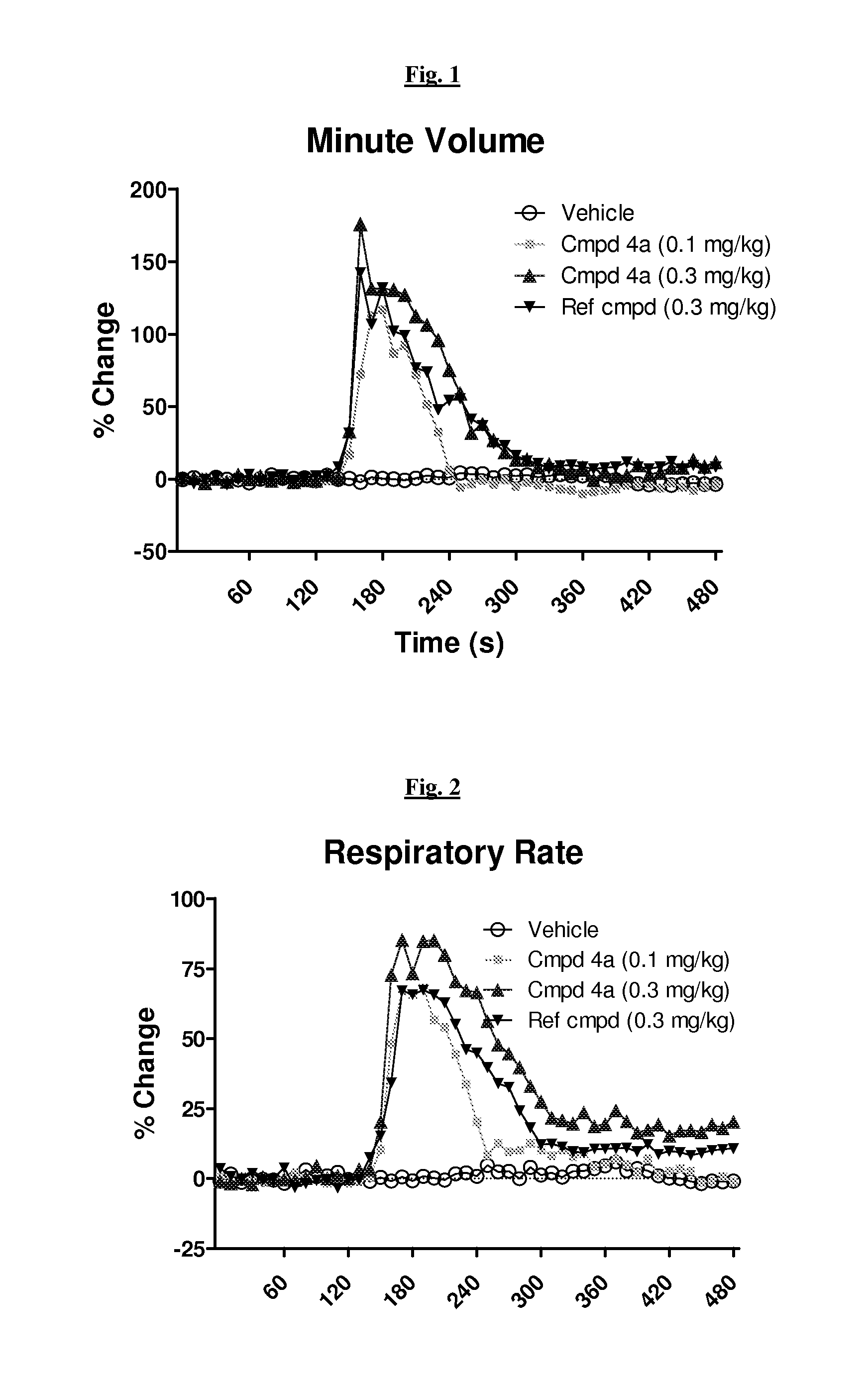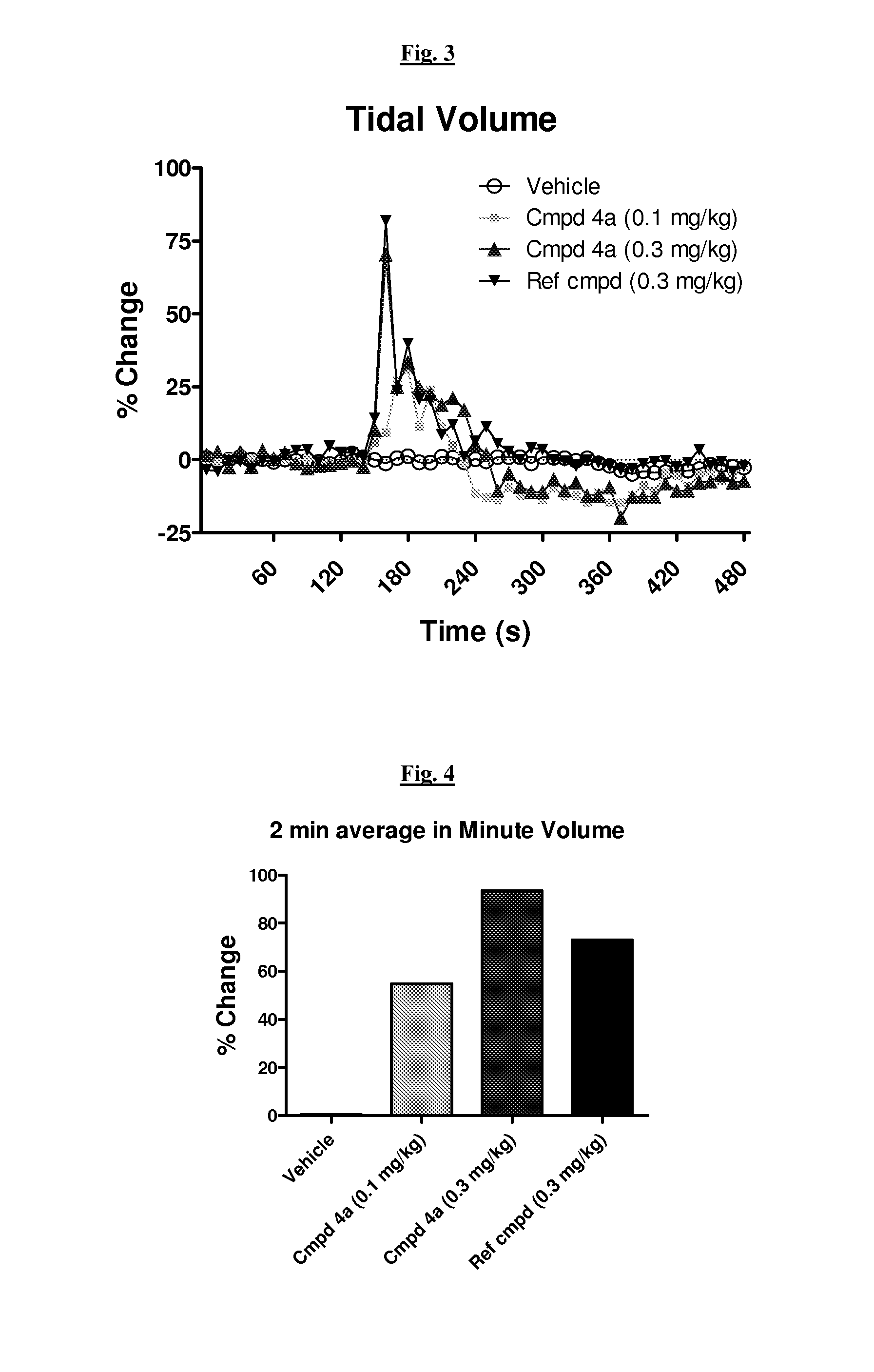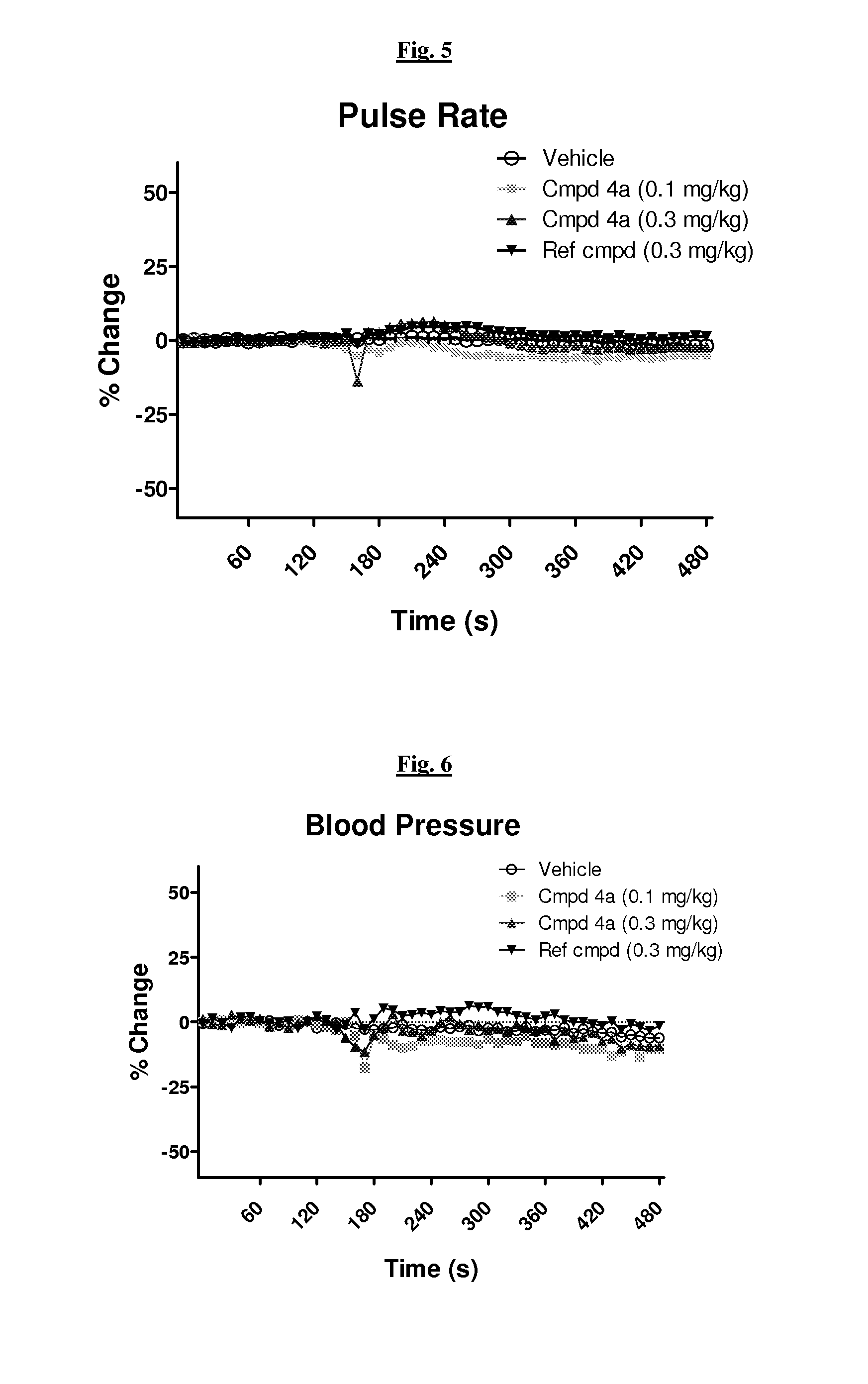Novel breathing control modulating compounds, and methods of using same
- Summary
- Abstract
- Description
- Claims
- Application Information
AI Technical Summary
Benefits of technology
Problems solved by technology
Method used
Image
Examples
example 1
N2,N6-Dimethyl-N4,N8-di-n-propyl-pyrimido[5,4-d]pyrimidine-2,4,6,8-tetraamine (3) and corresponding hydrochloride salt (4a) (Scheme 7)
2,6-Dichloro-N4,N8-di-n-propyl-pyrimido[5,4-d]pyrimidine-4,8-diamine (2)
[0443]To a solution of 2,4,6,8-tetrachloro-pyrimido[5,4-d]pyrimidine (1) (2.20 g, 8.15 mmol) in THF (55 mL), n-propylamine (2.68 mL, 32.60 mmol) in THF (15 mL) was added dropwise at 0° C. The reaction mixture was stirred at room temperature for 1 h. After this time, water (50 mL) was added and the resultant precipitate was filtered, washed with water (30 mL) and dried over P2O5 to yield 2,6-dichloro-N4,N8-di-n-propyl-pyrimido[5,4-d]pyrimidine-4,8-diamine (2) (2.49 g, 97% y). 400 MHz 1H NMR (CDCl3, ppm) δ 6.92-6.85 (2H, m), 3.56 (4H, td, J=7.3, 6.2 Hz), 1.73 (4H, sextet, J=7.3 Hz), 1.02 (6H, t, J=7.3 Hz). ESI-MS (m / z): 315, 317, 319 [M+H]+.
N2,N6-Dimethyl-N4,N8-di-n-propyl-pyrimido[5,4-d]pyrimidine-2,4,6,8-tetraamine (3)
[0444]The mixture of 2,6-dichloro-N4,N8-di-n-propyl-pyrimido[5,...
example 2
N2,N4,N6,N8-Tetra-n-propyl-pyrimido[5,4-d]pyrimidine-2,4,6,8-tetraamine (5) and corresponding hydrochloride salt (6a) (Scheme 8)
N2,N4,N6,N8-Tetra-n-propyl-pyrimido[5,4-d]pyrimidine-2,4,6,8-tetraamine (5)
[0446]A mixture of 2,6-dichloro-N4,N8-di-n-propyl-pyrimido[5,4-d]pyrimidine-4,8-diamine (2) (338 mg, 1.07 mmol), K2CO3 (296 mg, 2.14 mmol) and n-propylamine (2.20 mL) in n-butanol (4 mL) was heated at 150° C. for 45 h. After this time, the volatiles were removed by evaporation and the residue was partitioned between EtOAc (50 mL) and a saturated NaHCO3 solution (30 mL). The water phase was extracted with EtOAc (2×40 mL). The combined organic extracts were washed with water (50 mL), and then with a brine solution (50 mL), and lastly dried over solid anhydrous Na2SO4. After filtration, the solvent was removed and the residue was purified by flash column chromatography using gradient elution from CH2Cl2 to CH2Cl2 / EtOH (98:2) to yield N2,N4,N6,N8-tetra-n-propyl-pyrimido[5,4-d]pyrimidine-...
example 3
N2,N6-Di-n-butyl-N4,N8-di-n-propyl-pyrimido[5,4-d]pyrimidine-2,4,6,8-tetraamine (7) and corresponding hydrochloride salt (8a)
N2,N6-Di-n-but-N4,N8-di-n-propyl-pyrimido[5,4-d]pyrimidine-2,4,6,8-tetraamine (7)
[0448]2,6-Dichloro-N4,N8-di-n-propyl-pyrimido[5,4-d]pyrimidine-4,8-diamine (2) and n-butylamine were reacted using the procedure described for compound (3) to yield N2,N6-di-n-butyl-N4,N8-di-n-propyl-pyrimido[5,4-d]pyrimidine-2,4,6,8-tetraamine (7) in 85% yield. 400 MHz 1H NMR (CDCl3, ppm): δ 6.46 (2H, br s), 4.57 (2H, br s), 3.51-3.42 (4H, m), 3.42-3.32 (4H, m), 1.69 (4H, sextet, J=7.4 Hz), 1.63-1.54 (4H, m), 1.48-1.37 (4H, m), 1.00 (6H, t, J=7.4 Hz), 0.96 (6H, t, J=7.4 Hz). ESI-MS (m / z): 389 [M+H]+.
N2,N6-Di-n-butyl-N4,N8-di-n-propyl-pyrimido[5,4-d]pyrimidine-2,4,6,8-tetraamine hydrochloride (8a)
[0449]N2,N6-Di-n-butyl-N4,N8-di-n-propyl-pyrimido[5,4-d]pyrimidine-2,4,6,8-tetraamine hydrochloride (7) and 2M HCl / diethyl ether in CH2Cl2 / MeOH (15 / 1) were reacted using the procedure des...
PUM
| Property | Measurement | Unit |
|---|---|---|
| Temperature | aaaaa | aaaaa |
| Composition | aaaaa | aaaaa |
| Content | aaaaa | aaaaa |
Abstract
Description
Claims
Application Information
 Login to View More
Login to View More - R&D
- Intellectual Property
- Life Sciences
- Materials
- Tech Scout
- Unparalleled Data Quality
- Higher Quality Content
- 60% Fewer Hallucinations
Browse by: Latest US Patents, China's latest patents, Technical Efficacy Thesaurus, Application Domain, Technology Topic, Popular Technical Reports.
© 2025 PatSnap. All rights reserved.Legal|Privacy policy|Modern Slavery Act Transparency Statement|Sitemap|About US| Contact US: help@patsnap.com



